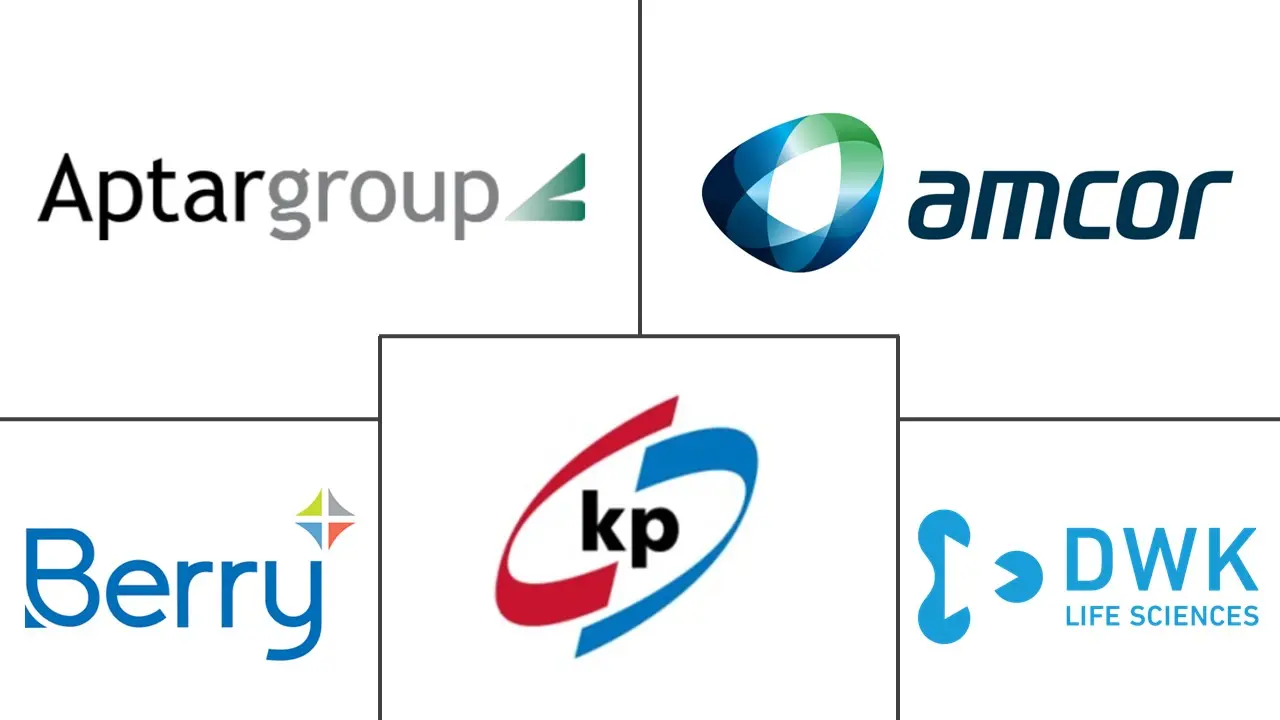Middle East And Africa Pharmaceutical Plastic Packaging Market Size and Share
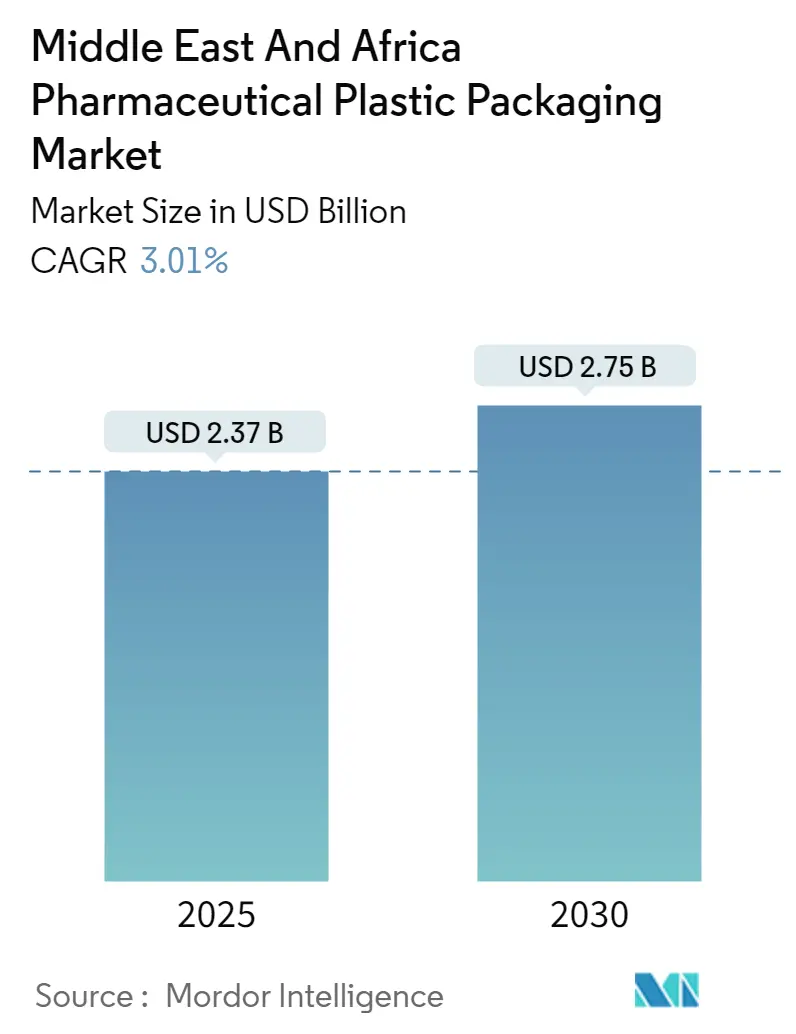
Middle East And Africa Pharmaceutical Plastic Packaging Market Analysis by Mordor Intelligence
The Middle East And Africa Pharmaceutical Plastic Packaging Market size is worth USD 2.37 Billion in 2025, growing at an 3.01% CAGR and is forecast to hit USD 2.75 Billion by 2030.
- Moisture resistance, high impact strength, tamper-proof qualities, and transparency are features fueling the pharmaceutical industry's increasing embrace of plastic packaging. Compared to glass, plastic offers advantages like resistance to elongation, low water absorption, and an extended shelf life.
- As the pharmaceutical industry expands, so does the need for adequate packaging, crucial for treating both communicable and non-communicable diseases. This packaging safeguards pharmaceuticals from damage, biological contamination, and external influences. Technological advancements in the pharmaceutical sector have spurred a heightened demand for bottles, vials, and other packaging solutions. Moreover, the surging demand for injectables and oncology drugs and rising per capita drug spending underscores the industry's growth trajectory.
- The United Arab Emirates is the Middle East's pharmaceutical hub, boasting the highest per capita medical spending and a robust healthcare infrastructure. Local manufacturers are ramping up medicine production, bolstered by significant multinationals and research-based companies like Pfizer, Novartis, and GlaxoSmithKline. Their established manufacturing and distribution channels in the United Arab Emirates present lucrative opportunities for the market.
- The market is poised for growth with the healthcare sector's escalating demand for tamper-proof and contamination-resistant medical product packaging. An aging population and the rising prevalence of chronic conditions fuel the expansion of flexible healthcare packaging. Flexible packaging materials are attractive because of their affordability, adaptability, and diverse size and form options.
- Saudi Arabia anticipates a significant shift toward domestically produced and packaged medications under the Vision 2030 long-term development plan and the National Transformation Program's shorter-term objectives. Only 30% of pharmaceutical items are locally made, signaling the vast potential for pharmaceutical packaging manufacturers. Furthermore, Saudi Arabia is positioning itself as a critical player, catering to its needs and other GCC and North African nations, as evidenced by a notable uptick in exports.
Middle East And Africa Pharmaceutical Plastic Packaging Market Trends and Insights
Rising Demand for Syringes and Injectables Driven by Aging Population and Chronic Diseases
- Producers increasingly favor plastic for pharmaceutical packaging, driven by a demand for cost-effective and high-value options. Manufacturers of parenteral medications and packaging solution providers are gravitating towards polymers like cyclic olefin copolymers (COC) and cyclic olefin polymers (COP). To meet this polymer demand, key players are collaborating. For instance, Schott Pharma has introduced syringes crafted from cutting-edge COC polymer.
- The growing population, coupled with an aging demographic and a rise in chronic diseases, is fueling the demand for syringes and injectables. Furthermore, swift advancements in medical technology, innovations from industry leaders, and evolving regulations on medical needle usage are set to energize the market further.
- Syringes have become the go-to tools for parenteral medication administration. A pre-fillable syringe, a type of disposable syringe, extracts drug substances from vials for varied administration routes. Primarily employed for chronic conditions like cancer and diabetes, these syringes excel in delivering medications. They ensure precise drug administration, minimize needle exposure, and eliminate the withdrawal phase, allowing immediate patient medication.
- Given the rise in chronic infectious diseases, the growing reliance on injectable medications, and technological strides in the syringe sector, the pre-fillable syringes market is poised for growth. For context, the International Diabetes Federation (IDF) reported 73 million adults with diabetes in the Middle East and Africa in 2021, a figure projected to soar to 135.7 million by 2045.
- The market is set to benefit from the rising adoption of injectable medications, advancements in syringe technology, and the broadening scope of vaccination and immunization initiatives.
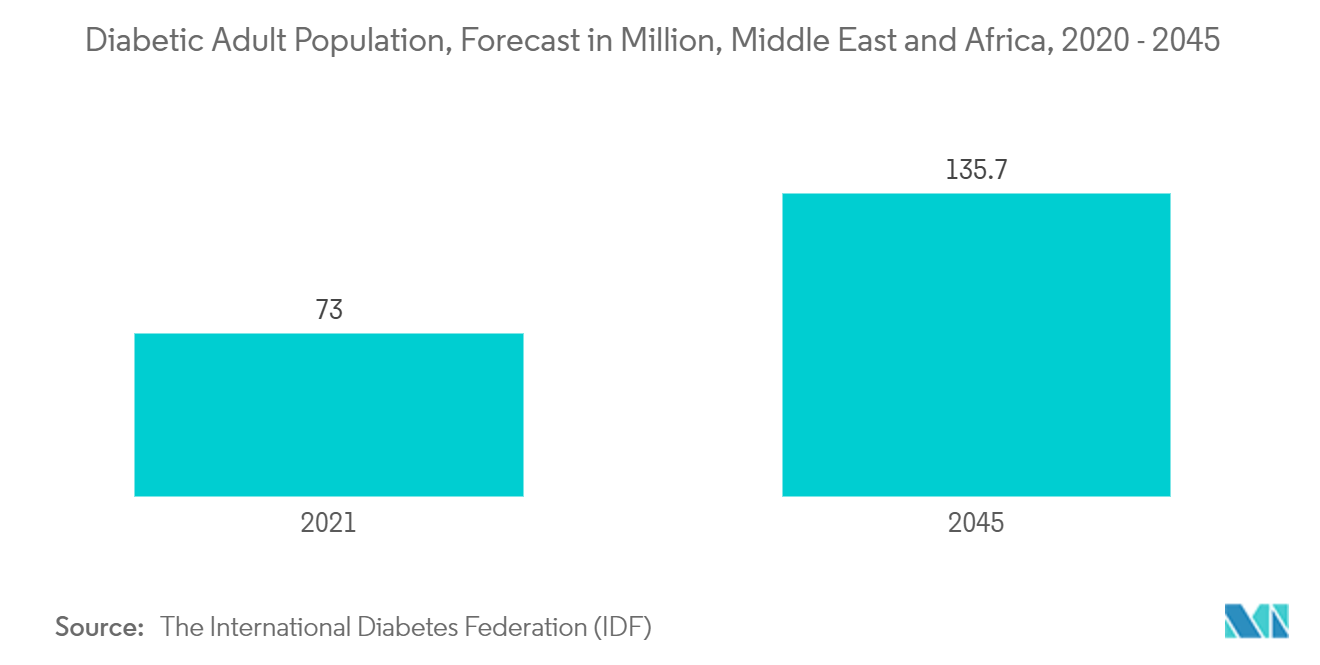
Saudi Arabia's Pharmaceutical Packaging Market is Boosted by Health Investments and Growing Demand
- Saudi Arabia's demand for pharmaceutical packaging is surging, driven by a rise in non-communicable diseases and an evolving healthcare infrastructure. Multinational corporations (MNCs) dominate the pharmaceutical packaging landscape in Saudi Arabia, commanding a significant market share. The industry is poised for growth with increasing healthcare costs and heightened health awareness. As reported by the International Trade Administration U.S. Department of Commerce, Saudi Arabia's pharmaceutical market is set to grow from USD 11.72 billion in 2022 to an anticipated USD 15.09 billion by 2027. The country's shift towards a more privatized and holistic healthcare system is expected to boost demand for patented and generic medicines, subsequently driving the need for pharmaceutical plastic packaging.
- Saudi Arabia's government is investing substantially in the healthcare sector to bolster the pharmaceutical market. Their focus spans enhancing healthcare service quality, adopting advanced medical technologies, and expanding the number of hospitals and healthcare facilities. The Saudi FDA oversees drug and medical device registration, evaluation, and approval. Furthermore, the government is rolling out initiatives to boost the availability of generic drugs, a move anticipated to curtail healthcare costs.
- Saudi Arabia's pharmaceutical packaging market is on the rise, fueled by health concerns and significant investments in the medical sector. A testament to this commitment, in June 2022-23, the Kingdom allocated USD 3.4 billion to the vaccination and biomedical medicine sectors. This initiative underscores Saudi Arabia's ambition to fortify its pharmaceutical industry and position itself as a central hub.
- Saudi Arabia's Vision 2030 outlines ambitious plans for enhancing healthcare access and quality, marking healthcare as a pivotal development pillar. With a substantial USD 66 billion investment in the private sector, the Kingdom is laying the groundwork for a world-class healthcare infrastructure. Highlighting the industry's potential, projections from the OECD indicate a 160% growth for the global pharmaceutical sector, while Saudi Arabia is set to outpace with a 171% growth from 2017 to 2030.
- Plastics, which are versatile in composition, are the material of choice for pharmaceutical containers. These containers are crafted to ensure no ingredients compromise the formulation's effectiveness, stability, or safety.
- Moreover, government regulations and toll duties on imported drugs incentivize pharmaceutical companies to source locally. This, combined with favorable conditions and legislative support, has spurred a surge in local manufacturers and collaborations between domestic and international pharmaceutical entities. Such strategic alliances are poised to amplify the demand for pharmaceutical production and packaging solutions.
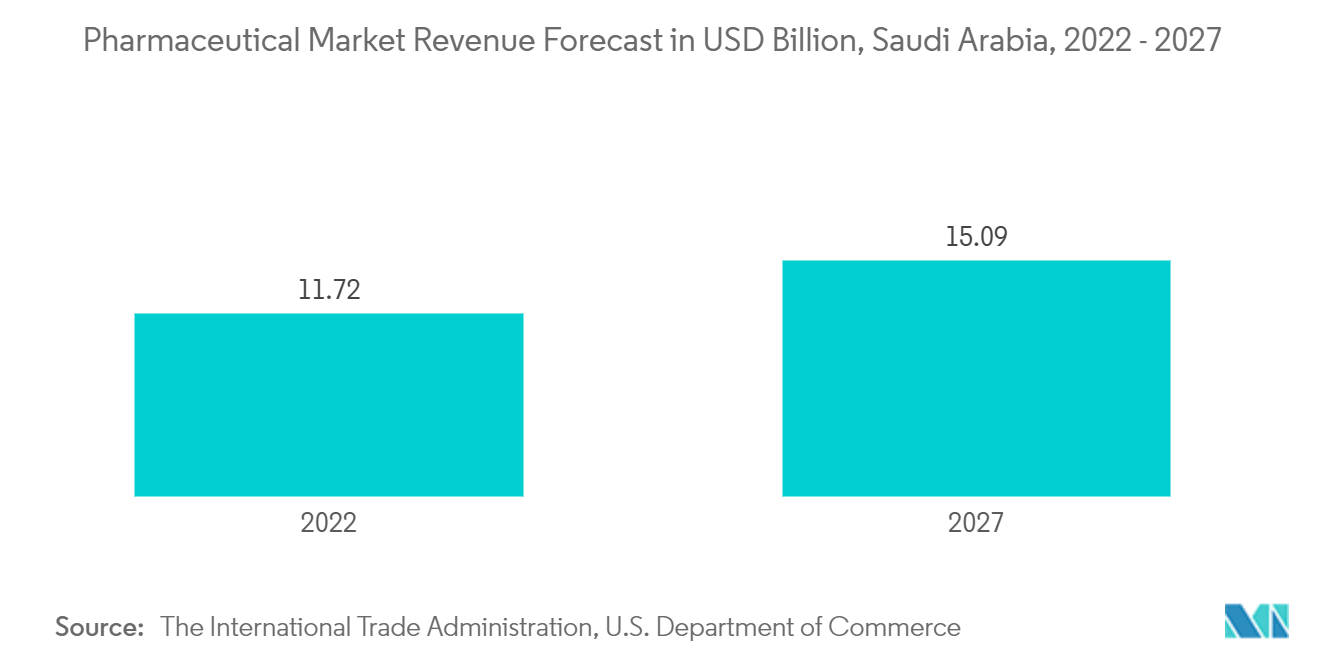
Competitive Landscape
The pharmaceutical plastic packaging market in the Middle East and Africa is characterized by a semi-consolidated landscape featuring local and global players. Prominent names in this arena include AptarGroup, Inc., Amcor Group GmbH, Berry Global Inc., ALPLA Werke Alwin Lehner GmbH & Co KG, Plastipak Holdings Inc., Klockner Pentaplast Group, DWK Life Sciences GmbH, and Revital Healthcare (EPZ) Ltd. These players seek to bolster their market share, emphasizing product launches and addressing sustainability concerns.
- January 2024: Aptar Pharma, a division of AptarGroup, Inc., commemorated the first anniversary of its innovative product, APF Futurity™. Designed for delivering nasal saline and similar over-the-counter (OTC) formulations, the APF Futurity™ is a pioneering metal-free, multidose nasal spray pump. Notably, this nasal spray pump boasts high recyclability and has proudly secured a Class AA certification from cyclos-HTP. With this launch, the company underscores its commitment to a sustainable future.
Middle East And Africa Pharmaceutical Plastic Packaging Industry Leaders
-
AptarGroup, Inc.
-
Amcor Group GmbH
-
Berry Global Inc.
-
Klockner Pentaplast Group
-
DWK Life Sciences GmbH
- *Disclaimer: Major Players sorted in no particular order
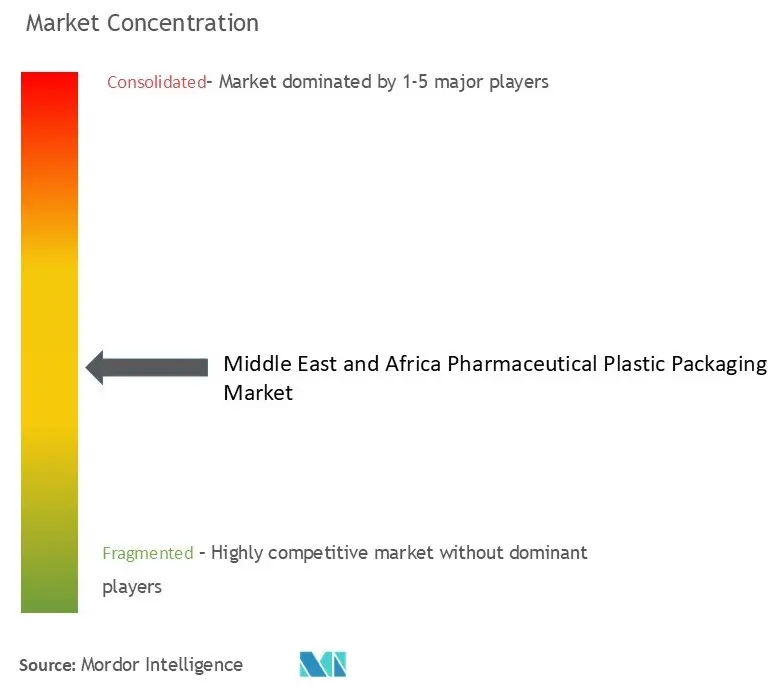
Recent Industry Developments
- April 2024: Berry Global Inc. celebrates the six-month milestone of its innovative lightweight tube closure solution, tailored for diverse personal care and pharmaceutical applications. This state-of-the-art closure seamlessly merges contemporary design and material adaptability, all while significantly curbing greenhouse gas emissions. Such advancements not only cater to customer performance needs but also reinforce Berry's dedication to reducing virgin plastic consumption.
- May 2024: ALPLA Werke Alwin Lehner GmbH & Co KG has launched the ALPLAinject division to bolster its injection molding operations. ALPLAinject produces high-quality injection-molded items, including closures, caps, jars, and multi-part packaging components like pumps and deodorant sticks. This expansion aims to enhance efficiency, accelerate the introduction of new products to the market, and tap into previously unexplored market segments.
Middle East And Africa Pharmaceutical Plastic Packaging Market Report Scope
Plastic, renowned for its mechanical strength, stability, and flexibility, has become a staple in various end-user industries, notably the pharmaceutical sector. Its cost-effectiveness and a range of mono materials tailored for diverse drugs and medications position plastic as a preferred choice for pharmaceutical packaging. Beyond its economic advantages, plastic packaging simplifies transportation and manufacturing processes. The region's concentration of major pharmaceutical manufacturers further bolsters the demand for plastic packaging solutions. This study evaluates revenues generated from the sales of diverse pharmaceutical plastic packaging products that market vendors provide. Additionally, the analysis incorporates the effects of geopolitical dynamics on the pharmaceutical plastic packaging landscape, considering prevailing scenarios, dominant themes, and demand cycles across end-user verticals.
The Middle East and Africa pharmaceutical plastic packaging market is segmented by raw material (polypropylene (PP), polyethylene terephthalate (PET), low-density polyethylene (LDPE), high-density polyethylene (HDPE), and other raw materials), product type (solid containers, dropper bottles, nasal spray bottles, liquid bottles, oral care, pouches, vials and ampoules, cartridges, syringes, caps and closures, and other product types), and country (United Arab Emirates, Saudi Arabia, South Africa, Egypt. and Rest of Middle East and Africa). The report offers market forecasts and size in value (USD) for all the above segments.
| Polypropylene (PP) |
| Polyethylene Terephthalate (PET) |
| Low Density Polyethylene (LDPE) |
| High Density Polyethylene (HDPE) |
| Other Raw Materials |
| Solid Containers |
| Dropper Bottles |
| Nasal Spray Bottles |
| Liquid Bottles |
| Oral Care |
| Pouches |
| Vials and Ampoules |
| Cartridges |
| Syringes |
| Caps and Closures |
| Other Product Types |
| United Arab Emirates |
| Saudi Arabia |
| South Africa |
| Egypt |
| By Raw Material | Polypropylene (PP) |
| Polyethylene Terephthalate (PET) | |
| Low Density Polyethylene (LDPE) | |
| High Density Polyethylene (HDPE) | |
| Other Raw Materials | |
| By Product Type** | Solid Containers |
| Dropper Bottles | |
| Nasal Spray Bottles | |
| Liquid Bottles | |
| Oral Care | |
| Pouches | |
| Vials and Ampoules | |
| Cartridges | |
| Syringes | |
| Caps and Closures | |
| Other Product Types | |
| By Country*** | United Arab Emirates |
| Saudi Arabia | |
| South Africa | |
| Egypt |
Key Questions Answered in the Report
How big is the Middle East And Africa Pharmaceutical Plastic Packaging Market?
The Middle East And Africa Pharmaceutical Plastic Packaging Market size is worth USD 2.37 billion in 2025, growing at an 3.01% CAGR and is forecast to hit USD 2.75 billion by 2030.
What is the current Middle East And Africa Pharmaceutical Plastic Packaging Market size?
In 2025, the Middle East And Africa Pharmaceutical Plastic Packaging Market size is expected to reach USD 2.37 billion.
Who are the key players in Middle East And Africa Pharmaceutical Plastic Packaging Market?
AptarGroup, Inc., Amcor Group GmbH, Berry Global Inc., Klockner Pentaplast Group and DWK Life Sciences GmbH are the major companies operating in the Middle East And Africa Pharmaceutical Plastic Packaging Market.
What years does this Middle East And Africa Pharmaceutical Plastic Packaging Market cover, and what was the market size in 2024?
In 2024, the Middle East And Africa Pharmaceutical Plastic Packaging Market size was estimated at USD 2.30 billion. The report covers the Middle East And Africa Pharmaceutical Plastic Packaging Market historical market size for years: 2019, 2020, 2021, 2022, 2023 and 2024. The report also forecasts the Middle East And Africa Pharmaceutical Plastic Packaging Market size for years: 2025, 2026, 2027, 2028, 2029 and 2030.
Page last updated on:
Middle East And Africa Pharmaceutical Plastic Packaging Market Report
Statistics for the 2025 Middle East And Africa Pharmaceutical Plastic Packaging market share, size and revenue growth rate, created by Mordor Intelligence™ Industry Reports. Middle East And Africa Pharmaceutical Plastic Packaging analysis includes a market forecast outlook for 2025 to 2030 and historical overview. Get a sample of this industry analysis as a free report PDF download.
